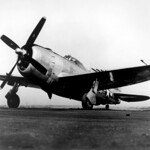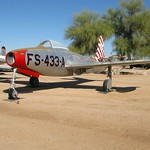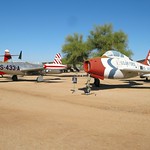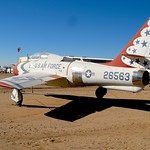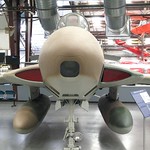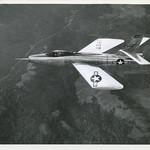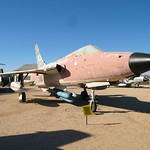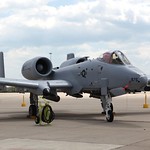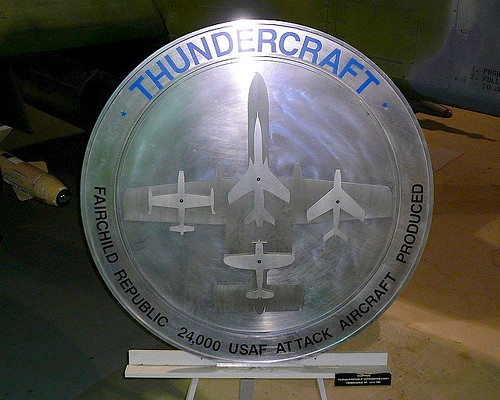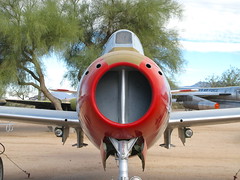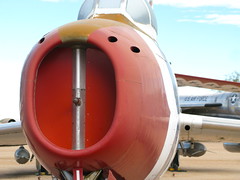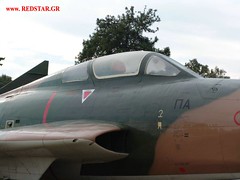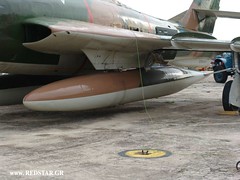Scroll to the bottom of this post to see two updates added on 10/29/13 and 10/30/13.
 I originally planned to put irony quotes around the word Thundercraft, since no USAF pilot I know would be caught dead using the term. But what the hell, it was Republic’s collective name for the fighter-bombers they designed and built from the 1940s to the 1970s, important aircraft with long combat records, so I guess they earned the right to call them Thundercraft … even if it makes ’em sound like something the ThunderCats would fly!
I originally planned to put irony quotes around the word Thundercraft, since no USAF pilot I know would be caught dead using the term. But what the hell, it was Republic’s collective name for the fighter-bombers they designed and built from the 1940s to the 1970s, important aircraft with long combat records, so I guess they earned the right to call them Thundercraft … even if it makes ’em sound like something the ThunderCats would fly!
If you click on the magazine ad to your left you can see it full size on Flickr. In it you’ll see that Republic … or at least their PR people … actually called them Thunder-craft, with a hyphen.
Here’s the quick and dirty on Republic and its Thundercraft:
The enterprise started out as the Seversky Aircraft Company in Farmingdale, Long Island, New York. Seversky built aircraft from 1931 to 1939 and was most known for a mid-1930s design, the P-35 pursuit fighter. In 1939 the corporate board evicted the founder, Alexander de Seversky, and reorganized as the Republic Aviation Corporation. As Republic, the company became famous for a series of fighters bearing Thunder names, including:
- The P-47 Thunderbolt, which flew from 1941 into the mid-1950s
- The straight-wing F-84 Thunderjet, which flew from 1946 into the mid-1960s
- The swept-wing F-84 Thunderstreak, which flew from 1949 to 1972 (Greece continued to fly them until the early 1990s)
- The swept-wing RF-84F Thunderflash, which flew from 1952 to 1972
- The mighty Thud, the F-105 Thunderchief, which flew in single-seat fighter/bomber versions and two-seat Wild Weasel variants from 1955 to 1984
- The A-10 Thunderbolt II, designed and built after Republic became a division of Fairchild Republic Aircraft, introduced in 1972 and still flying today
The propeller-driven P-47 Thunderbolt was one of the most highly regarded fighters of WWII, so it was probably natural for Republic to name its first jet fighter-bomber the Thunderjet. As with nearly all nuclear-era jet fighters, the F-84 Thunderjet was designed to carry a tactical nuke, and nuclear strike was one of its missions. The original “stovepipe” jet fighter, it was otherwise lightly armed, with six .50-inch machine guns (300 rounds each) and hard points capable of carrying 4,450 pounds of conventional ordnance.
Although the first model, the F-84B, went into USAF service in 1947, it was almost immediately grounded due to handling problems and structural failures. The USAF came close to canceling the F-84 buy, but a subsequent model, the F-84D introduced in 1949, addressed those problems, and earlier B and C models were later brought up to D model standards. The E model was better yet, but spare parts for the engines were a constant problem and it was not until the 1951 introduction of the G model that the Thunderjet, with a later version of the Allison J35 engine, became less of a maintenance nightmare and more of an operational front-line fighter.
The Thunderjet was the first USAF jet with air-refueling capability; it was also the first aircraft used by the USAF Thunderbirds aerial demonstration team. F-84D, E, and G models saw combat in the Korean War, where they were credited with 60% of all ground targets destroyed and eight MiG-15 kills, even though the straight-wing Thunderjet was vastly inferior to the swept-wing MiG (the North Koreans, by the way, claimed 64 F-84 kills by MiG-15s). The airplane had many nicknames, among them Lead Sled and Groundhog, both names referring to its reluctance to part company with the runway. The non-afterburning Allison engines produced only about 5,000 pounds of thrust, and with full combat loads on hot summer Korean days Thunderjets needed 10,000-foot-long runways to operate safely. Thunderjet pilots joked that there was a sensor in the nose that would not allow the tires to break free of the ground until it smelled the dirt and grass at the far end of the runway.
Although North American Aviation committed to swept wings in 1947 when it designed the F-86 Sabre, Republic didn’t follow suit until 1949, when it began development of the F-84F Thunderstreak. The Thunderstreak was Republic’s attempt to bring the F-84’s performance up to that of the F-86. Despite it’s F-84 designation and similar “stovepipe” fuselage design, though, the Thunderstreak was a different aircraft from the Thunderjet, with few parts and tooling in common. Introduced in 1952, the Thunderstreak, like its predecessor, was full of problems and didn’t really enter service until 1954.
The Thunderstreak was also nuclear-capable. Like the Thunderjet it had six .50-inch machine guns, but could carry a heavier conventional bomb load and rockets for the air intercept role. It used a newer engine, the Wright J65 with over 7,000 pounds of thrust. As with the Thunderjet, there was no afterburner. A reconnaissance variant with a camera nose and wing root intakes, the RF-84F Thunderflash, was introduced in 1954. The recce version, interestingly enough, retained four of the six .50-inch machine guns of its fighter-bomber sister.
There were some interesting offshoots of the F-84 family, including the XF-91 Thunderceptor prototype, a composite aircraft with both rocket and jet propulsion and an unusual wing design, a mid-1950s turboprop prototype called the XF-84H and nicknamed “Thunderscreech” in honor of being the loudest aircraft ever built this side of the Tupolev Bear bomber, and an escort fighter variant that made it into production and actually saw service in the early 1950s, the RF-84K Fighter Conveyor (FICON) Thunderstreak, which was carried aloft, launched, and recovered in mid-air by a B-36 bomber mothership.
The Republic jet that became the F-105 Thunderchief was developed in the early 1950s in response to an Air Force requirement for a fighter-bomber that could penetrate Soviet defenses at low altitude and high speed while carrying a single nuclear bomb in an internal bay. First flown in 1955, it entered USAF service in 1958. The F-105D was, at least through the early years of our war in Vietnam, our primary strike bomber; it could carry twice the bomb load of the North American F-100 it replaced, but its survivability was so poor (395 F-105s were lost to enemy action, mostly ground fire, about 50% of the total fleet) that the Thud was eventually withdrawn from combat and replaced by the McDonnell F-4 Phantom II. Still, in addition to its bomb load the F-105 packed Sidewinders and an internal 20mm Vulcan Gatling gun cannon, and Thud pilots scored 27.5 confirmed MiG-17 kills in Vietnam. Two-seat F and G models, flying the suppression of enemy air defense (SEAD) role and commonly called Wild Weasels, continued to fly in theater until the end of the war.
Thuds were enormous aircraft, initially regarded with suspicion by USAF pilots but eventually held in high esteem, legendary for their speed at low altitude … a story I heard more than once during my flying days involved a two-ship of Thuds coming off a heavily defended target up north, with the wingman streaking south at treetop level at close to 900 knots indicated, only to be passed by lead, who radioed “Push it up, Two, let’s get the hell out of here.”
In the mid-1970s, concurrent with the introduction of the fighter I flew during my career, the McDonnell-Douglas F-15 Eagle, Fairchild Republic was fielding the first of the A-10 Thunderbolt II ground attack fighters. The A-10, universally called the Warthog, was designed to provide close air support to friendly forces. In that mission it would operate at low altitude in a highly hostile environment, so it was built to be rugged and survivable, not fast, sleek, and pretty like earlier Republic jets. And it packed … still packs … a punch: a 30mm Gatling gun cannon in the nose and the ability to carry up to 16,000 pounds of ordnance, 2,000 pounds more than the mighty Thud could carry. The one thing the Thunderbolt II doesn’t have in common with the Republic F-84s and F-105s that preceded it is nuclear capability.
The USAF was at first uncomfortable with the A-10, primarily because it was perceived as being built to fly Army missions, but after its performance in Desert Storm in 1991, when A-10s were credited with killing more than 900 Iraqi tanks, 2,000 other military vehicles, and 1,200 artillery pieces, the USAF realized it had a winner on its hands … in fact it was the most effective USAF airplane to operate during the Gulf War, and it has continued to provide combat close air support in Bosnia, Afghanistan, Iraq, and Libya. Unless it’s retired early for budgetary reasons, the USAF plans to keep a number of A-10s in service until 2028.
But I will say once again, in closing, that no USAF pilot ever, at any place, at any time, uttered the word “Thundercraft.” Still, that’s what Republic called it’s family of fighters, and the Thundercraft name survived into the Fairchild Republic A-10 days. What, you don’t believe me?
References:
- Republic Aviation Corporation
- Republic P-47 Thunderbolt
- Republic F-84 Thunderjet
- Republic F-84 Thunderstreak & Thunderflash
- Republic F-105 Thunderchief
- Fairchild Republic A-10 Thunderbolt II
- My Republic Thundercraft photoset on Flickr
Update (10/29/13): As noted above, both versions of the F-84 (straight-wing Thunderjet and swept-wing Thunderstreak) were armed with six machine guns. So why do I count only four gun ports on the photos of the jets I took at the Pima Air & Space Museum? I was at the museum this morning for a meeting and walked out to take a closer look afterward. Now I know: four in the nose, one in each wing root.
Update (10/30/13): My sources say the RF-84F Thunderflash retained four of the six machine guns mounted on the Thunderjet and Thunderstreak. It’s rare to see a recce bird so armed, which is why I made a note of it above. But looking at the photo of my museum’s Thunderflash, I couldn’t see the gun ports, so I made another trip to the museum to take a closer look. I couldn’t find a single gun port on our Thunderflash. After I got home I did some additional research and learned the guns were mounted just outboard of the engine intakes. After a little searching I found photos of a Hellenic AF Thunderflash with the gun ports clearly visible. These ports are covered on our museum’s Thunderflash and I don’t know why. Perhaps some USAF RF-84Fs flew without guns? I’ll keep digging, obsessive that I am!
